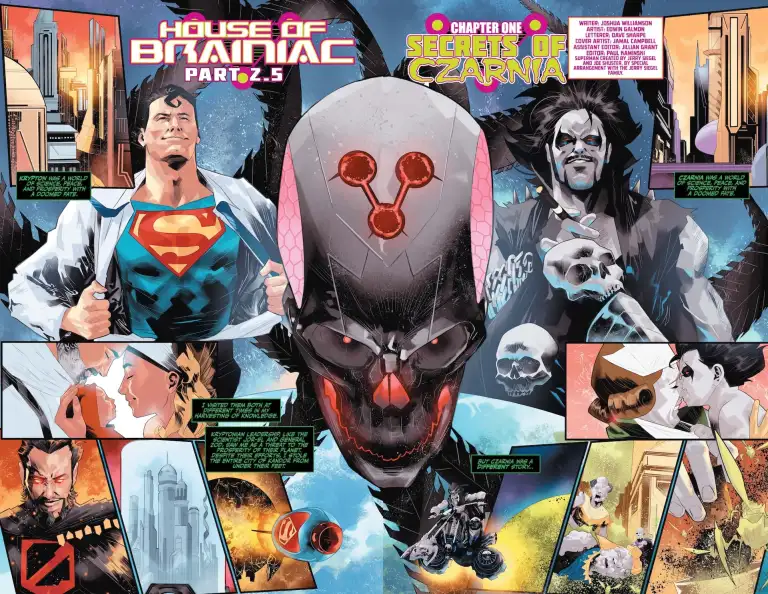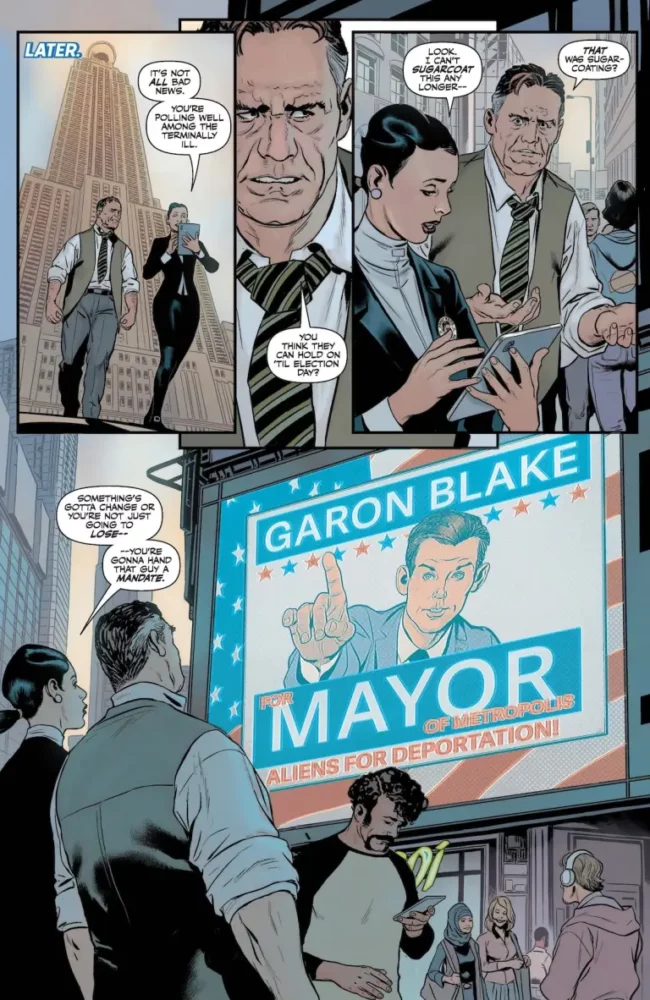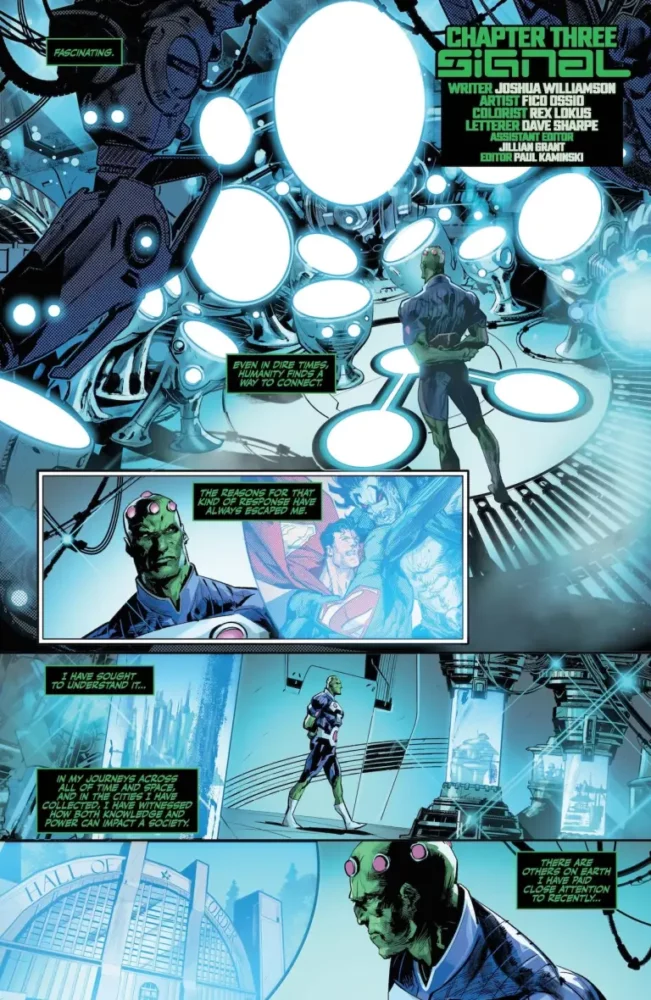Superman: House of Brainiac Special #1 is out now, and acts as both exposition and interlude to DC’s “House of Brainiac” event, featuring three main stories.
The first story in this issue is by writer Joshua Williamson, artist Edwin Galmon, and letterer Dave Sharpe, and it shows the reader what exactly Brainiac’s connection to Lobo’s home world is. Not only that, but also how he has the Czarnian army in his possession now. It retells the story of Brainiac’s initial journey to the planet, and a deal that he made with a scientist that swayed him from capturing and preserving the planet in his ship.
The second story takes place back on Metropolis. By writer Mark Russell, artist Steve Pugh, colorist Jordie Bellaire, and letterer Sharpe, a tale is told from the perspective of Bibbo, owner of the Ace O’ Clubs bar and a recurring character in Superman’s circle. While he narrates the story, it follows Perry White’s struggles as he campaigns to be mayor of Metropolis. The story doesn’t tie into the event much aside from a reference later on in the story explaining that the heroes are gone, so it’s time for the people of Metropolis to show that they can take care of themselves.
The final story is again written by Williamson and lettered by Sharpe, accompanied here by artist Fico Ossio and colorist Rex Lokus. This story is told from Brainiac’s perspective and follows Amanda Waller, desperate for knowledge and power. Peacemaker and Peacewrecker report back to her, telling her that they were unable to capture Professor Ivo. She leaves after this and tries to find out who comprises the Council of Light, and ends with a reveal built up to since the beginning of the Dawn of DC initiative.

WRITING
Williamson’s first story provides some necessary backstory for how Brainiac got to where he is right now. Williamson provides an easy to understand backstory for the Czarnian army, and manages to connect it to the rest of the story by showing how exactly Brainiac got this army of his. Brainiac narrates this first part of the issue, and Williamson’s voice for the character is in line with the previous two installments of the storyline. He shows that he really understands the character by putting Brainiac’s curiosity and lust for knowledge on full display. Brainiac’s quest has always been one for knowledge, and Williamson expands on that by telling the story of a planet and a city that truly piqued his interest. One thing Williamson does especially well is show how Brainiac is merely a detached scientist testing a hypothesis. He has Brainiac interact with a few of the people from this world, but allows the reader to see it in a way that increasingly shows Brainiac not necessarily toying with the Czarnians, but attempting to understand them better in every way as the story progresses.
Forward to Williamson’s other story—the third one—we again see Brainiac taking whatever information he can from his actions. Not only is his focus on what his plan is and what’s taking place in his ship, but also what was left in the wake of that. It’s almost like he threw a rock in a pond just to observe the ripples of water. Any writer with a solid plan for a story has the potential to write a good Amanda Waller, because it’s almost as if whatever the author knows, she knows it as well. Because of that, Williamson’s Waller is fantastic at making her presence known. He clearly has big things in store, which is why this story of her discovering something that she previously wasn’t aware of works so well. She takes charge of the situation, and even threatens the higher power before her.
Backtracking a little to the middle story, Russell provides a surprisingly emotionally charged story that was pretty unexpected to see in this special. It’s about being informed, and the choice to have Bibbo being the narrator was a good one. It shows that even the most old fashioned citizens of Metropolis can change their ways and help unite people towards a greater good. It can be a little heavy handed in its execution at times, but it ultimately works in favor of the story that’s being told. He gets Perry across as not a perfect hero, but one who can understand the difference between right and wrong. Russell shows how being in such a close proximity to Superman for so long can really change people, and it’s interestingly explored here through Perry.

ART
Starting with Galmon’s work in the first story, we’re immediately taken to Brainiac’s ship where he watches the events of the last issue unfold. Galmon really does a great job showcasing Brainiac’s higher technology. The room where Brainiac watches what’s happening with Superman and on Earth is futuristically designed and gives a small glimpse of his intelligence. Later, we see Brainiac’s whole ship floating above a Czarnian city from a low angle that really manages to capture the terror of the situation. The perspective of being someone on the ground looking up at it is one that serves the story well, and really lets the weight of Brainiac’s actions sink in. Not only that, but he also manages to give each Czarnian citizen a very distinct look that can either display a lot of insanity and bloodlust, or show a sort of pretentious façade. It’s a really impressive range.
Pugh takes care of the story back in Metropolis, and he really excels at capturing interpersonal relationships between two characters. Because of that, he fits the story perfectly. For example, there’s a page between Lois Lane and Perry White where the two stand together, talking. There’s no background, it’s just the two of them. They’re surrounded by floating heads of each other as the conversation flows, and it feels natural because of that. Pugh details every single look, and it really feels like every character really takes in what the other is saying, and reacts because of that. There’s an alien mother and daughter shown earlier in the story. The daughter is curious and confused as to why she can’t join the people protesting them, but the mother is worried and holding her child back, protecting her. Pugh expresses every character in the situation their in in a way that is bound to connect the reader to them further than the words alone ever could.
Ossio takes over the final story, where the focus is mostly on Amanda Waller. There’s an interesting parallel here where Brainiac is standing in front of this room of screens, enamored by what he’s seeing and learning from it. Those screens, however, are all positioned lower than him. He is in control. On Waller’s side though, we see her standing in a room with the screens of the Council of Light all hanging above her head. As she becomes more and more in control, the screens lower until they’re finally on the same level as her. She took control.

COLORING
Galmon colors his own work in that first story, and his art really thrives because of that. On a page where Superman and Lobo are both being presented with Brainiac’s ship cutting between them, Superman’s side is filled with brighter colors while Lobo’s is filled with darker ones. The Superman side of the image also features a panel where his Kryptonian parents hold him, a white background filling the space. With Lobo, he bites the nose of the nurse and the background is this peach color with white strikes interrupting it, giving this frantic sense to it. Czarnia’s orange skies also contrast Brainiac’s green and purple ship well. The orange skies almost blend into the fires on the ground, really cementing this place as a breeding ground for chaos.
Bellaire on the middle story does a great job capturing the small moments that are meant to get the tone across. Bibbo is shouting into a phone at one point, and the background is a lighter orange outlined by a spike darker one. Later, with the page mentioned earlier of Lois and Perry talking, their talking heads above them are both blue as we hear Lois’s side of the story. When we hear Perry’s side of it, he’s captured in this sterner red tone. Later in the story too, during a debate between Perry and his competitor, an orange color fills the background as tensions raise. When they finally reach a boiling point, it becomes a blood red. Bellaire’s coloring supports both Pugh’s art and Russell’s writing through this.
Lastly, we have Lokus’s coloring. There’s a part in this story where we’re faced with multiple Brainiacs, and each one is differentiated through their designs. Something to keep in mind though is how the shade of purple on each one is different. An earlier iteration of the character is covered in a more pinkish shade while the current one rocks circles of bright pink around his body, but is mostly clothed in a darker purple. The color of each fits the time period that they’re from. When Waller is faced with the light later, it’s brighter as its higher above her, and then a darker blue when it’s on her level. It does well to further what Ossio tries to convey while also giving each of the Brainiacs their own personality.
LETTERING
The lettering for the entire issue is handled by Sharpe. He does a great job throughout, and it’s a lot to get through. First is Brainiac’s green and black speech bubbles that are never misshapen. They’re constantly these perfect rectangles that only change when Brainiac actually speaks, becoming these ovals with machinelike breaks in them. It’s almost like the speech bubble itself is trying to contain more information, but can’t. In Russell’s portion of the issue, there’s a blog post spreading misinformation that is shown in all caps, where someone following it types in lowercase. The louder one gets the point across while the quieter one takes in the information. The white background of the post is broken by this gray box with Bibbo’s narration, combating what is said here. Sharpe is clearly very careful in his placement, which is also shown by his work in the third story. The Brainiac lettering returns, but the Waller’s speech bubbles are really what deserve some focus as well. Every emphasized word feels like it carries a weight behind it that almost makes you scared of her. What is actually said in her bubbles is spaced out well too. On one side, you’ll have her setting up a point that she then executes in the bubbles on the other side of her head. It splits up the hammer of her words falling in a way that draws the reader in.
CONCLUSION
DC’s Superman: House of Brainiac Special #1 is a welcome interlude to the main story that Williamson is writing, where Russell is also able to shine and provide a different perspective on what’s happening. With all the creators working on this issue, it’s also a diverse work that really gives multiple artists and colorists the spotlight, allowing them to be a part of this. Williamson, Russell, Galmon, Pugh, Ossio, Bellaire, Lokus, and Sharpe all work together to give a deep looks into the minds of Brainiac and Amanda Waller while also exploring what the fallout of this event could be.

